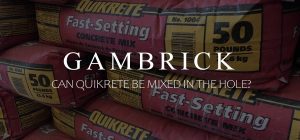
Do Concrete Countertops Crack?
Concrete countertops can crack just like anything made out of concrete, but not all cracks are the same, and some are more serious than others. There are a few common ways a concrete countertop can crack. The first is structural cracks that run deep into the slab, which are usually caused by an installation error. If the concrete countertop mix is wrong and the concrete is weak, it can crack under its own weight. Concrete countertops can crack if they lack reinforcement like wire mesh or rebar or if it’s not properly supported by the cabinets below. Concrete countertops are strong and can support heavy loads, but only if they’re built properly. A non structural crack is called a hairline. These tiny surface-level cracks are a cosmetic issue and are caused when the concrete dries too quickly.
There’s a big difference between a structural crack and a cosmetic crack. Cosmetic hairline cracks aren’t a big deal on a foundation, driveway, or sidewalk, but they’re a more serious issue when on a countertop. Concrete countertops are a finished product and need a smooth surface free of cracks and large imperfections. A small bubble pit on the side here and there is perfectly fine and can even add to the beauty of the slab, but cracks are a problem.
Concrete countertops crack because of an installation error. This is one of the challenges you’ll face when building your own. Always make sure the concrete mix ratio is correct, that you use the right ingredients, and that the slab is reinforced and supported. Also, make sure that the concrete dries slowly to prevent hairline cracks.
In this article, we’ll discuss concrete countertop cracks and how to avoid them.
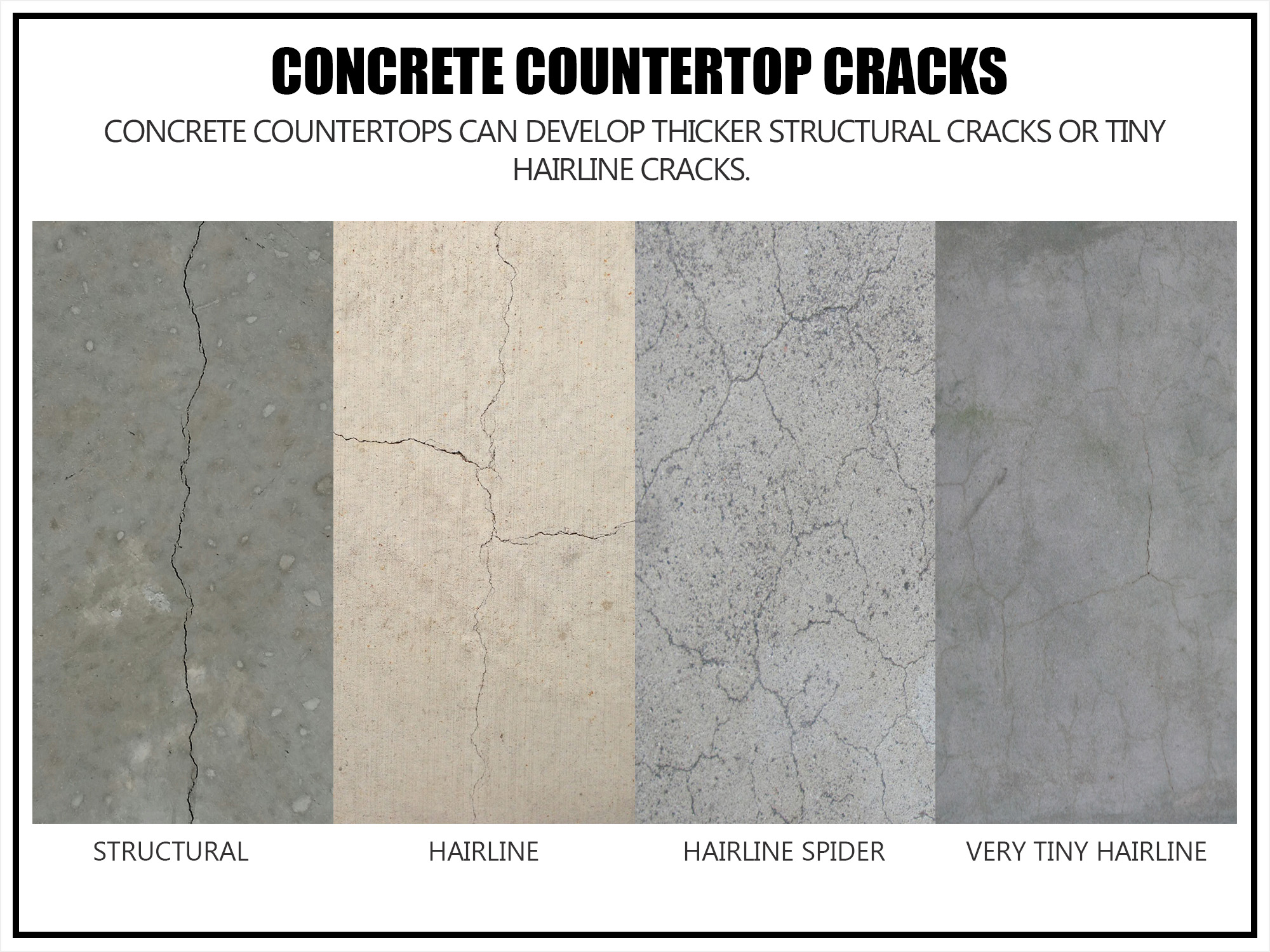
Concrete Countertop Hairline Cracks
Hairline cracks are very tiny in width and depth. Typically about the size of a human hair. Concrete is a mixture of cement, stone and sand that’s mixed with water. The cement chemically reacts with water to become a paste. The cement paste acts like a glue that binds sand and stone together. As the cement dries it also hardens like a rock. This is called curing and takes around 28 days to complete.
As the concrete transforms from semi-solid paste to rock like structure, it dries. Water is released from the concrete countertop and evaporated. This is why the surface of concrete gets damp as it hardens.
Concrete has to cure slowly to avoid cracking. If it dries too fast the surface can develop hairline cracks, which are also called craze cracks. These cracks can also be formed by expansion and contraction caused by water and heat.
To prevent your concrete countertops from developing hairline cracks, make sure it dries slowly. The best way to do it is to keep the surface of the countertops moist. Concrete countertops crack during the initial hardening phase so keep a close eye on them the first day after you pour.
You can try covering the slab with plastic. Don’t let the plastic touch the surface because it can leave a discoloration. Use some tape or sticks to keep the plastic about an inch above the counter.
Over troweling the countertops can also cause hairline cracks because it draws moisture out of the concrete.
If you see hairline cracks start to develop, wet the surface and trowel them away. Then keep the surface moist as it cures.
Controlling Hairline Cracks With Waterproofing
After the initial drying phase, hairline cracks are rare, but they can still occur. Luckily there are some things you can do to prevent them. Concrete is a highly absorbent material. It’s made up of pores that absorb water like a sponge. This can lead to stains and discoloration. To prevent the countertops from absorbing water, the concrete should be sealed.
A good quality sealant fills the concrete’s pores and adds a thin layer of protection over the surface. This layer sits between the stains and concrete like a coat of wax on a car. Spilled liquids will bead or pool instead of penetrating into the slab.
A concrete countertop sealer is just like a coat of wax on a new car. The wax protects the cars paint job by sitting on top of the paint. As long as the wax, or sealant, stays on, the car, or countertop, is protected. This means you need reapplication periodically.
But what about the underside of the slab? This is an area where most people don’t seal the concrete. Around moist areas like dishwashers and sinks, moisture can penetrate into the countertop through the bottom. This can lead to cracks.
Hairline cracks are caused by shrinkage. When the concrete dries too quickly, or gets wet and dry repeatedly, it can crack. To prevent hairline cracks you need to seal the entire slab, not just the top surface.
To control hairline cracks, I coat the bottom side of my concrete countertops with a waterproofing membrane. You can’t see the underside of the countertops so the waterproofing can be solid and much stronger than a basic sealer.
A waterproofing membrane is a permanently layer that waterproofs the exposed bottom of the slab while you protect the top with a sealant.
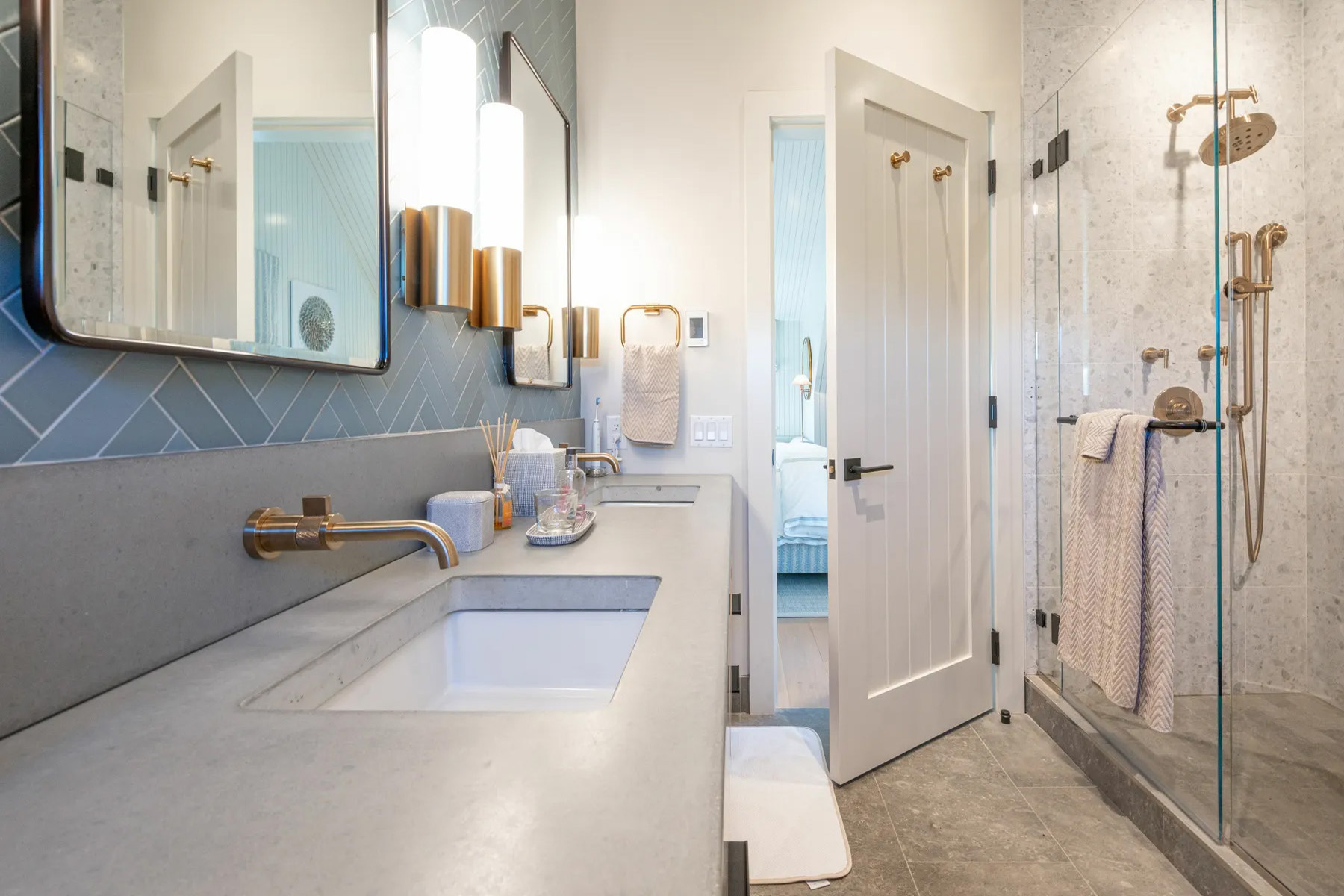
Structural Concrete Countertop Cracks
Structural concrete countertop cracks are more serious than hairline cracks. They’re deeper, wider and can cause the countertop to fail. Concrete is a very dense and rigid material. It has a high compressive strength, which means it can support a lot of weight, but low tensile strength. This is the strength you need to resist bending or twisting. Because of this weakness, concrete countertops need reinforcement like wire mesh or rebar inside the slab. And they also need proper support by the cabinets.
If the concrete doesn’t have reinforcement inside and/or isn’t properly supported by the cabinets, it can easily crack.
To further strengthen a concrete countertop, fiber or chemical additives can be included in the wet mix. This can give concrete more strength, crack resistance and flexibility.
A concrete countertop has two problems. The first is that countertops are very thin at just 1 1/4 inches. This is very thin for a concrete slab and makes them more prone to cracks. Second is that countertops need to have a concrete mix ratio with more cement because you need the surface to be smooth. More cement means weaker concrete that cracks easier.
Because concrete countertops have more cement in the mix and are thin for a slab, you have to reinforce and fully support them.
To avoid structural cracks, I recommend using wire mesh or 1/4″ steel rebar inside the slab. I also use both fiber and chemical additives inside the mixture. Also make sure every part of the countertop is supported by a base cabinet. In places where the counter must span a distance without a cabinet, such as over a dishwasher, use additional rebar to strengthen that area.
How To Prevent Concrete Countertop Cracks
There are two main types of cracks you’ll have to prevent when pouring concrete countertops. Most cracks are caused by installation errors. If you mix the concrete correctly and take certain steps during the build, your concrete countertops shouldn’t crack.
Hairline: To prevent hairline cracks you need to keep the surface of the countertops moist as it dries. The cause of hairline cracks, also called craze cracks, is drying too fast. Usually hairline cracks appear in the first day or two after the concrete has been poured. It’s during this short time frame that you have to be mindful.
If the surface is drying too fast, use a spray bottle to mist water over the surface of the concrete. You can also cover the counters with a plastic sheet. Keep the plastic about an inch over the concrete.
Structural: To prevent structural cracks in your concrete countertops, make sure the slab is reinforced and supported. Use reinforcement inside the slab like wire mesh and rebar. Use extra rebar in areas where the counter spans a long distance. This is usually over appliances or a sink base.
Make sure the counters are fully supported by the cabinets below. If there are unsupported areas, those spots are more prone to cracks.
Use fiber and chemical additives inside the mixture to increase the concrete’s strength, flexibility and crack resistance.
Mix: Use the proper concrete mix ratio. I’ll be writing an article on how to mix concrete for countertops soon and will leave a link. If you’re not mixing your own concrete, use a bagged concrete that’s made for countertops.
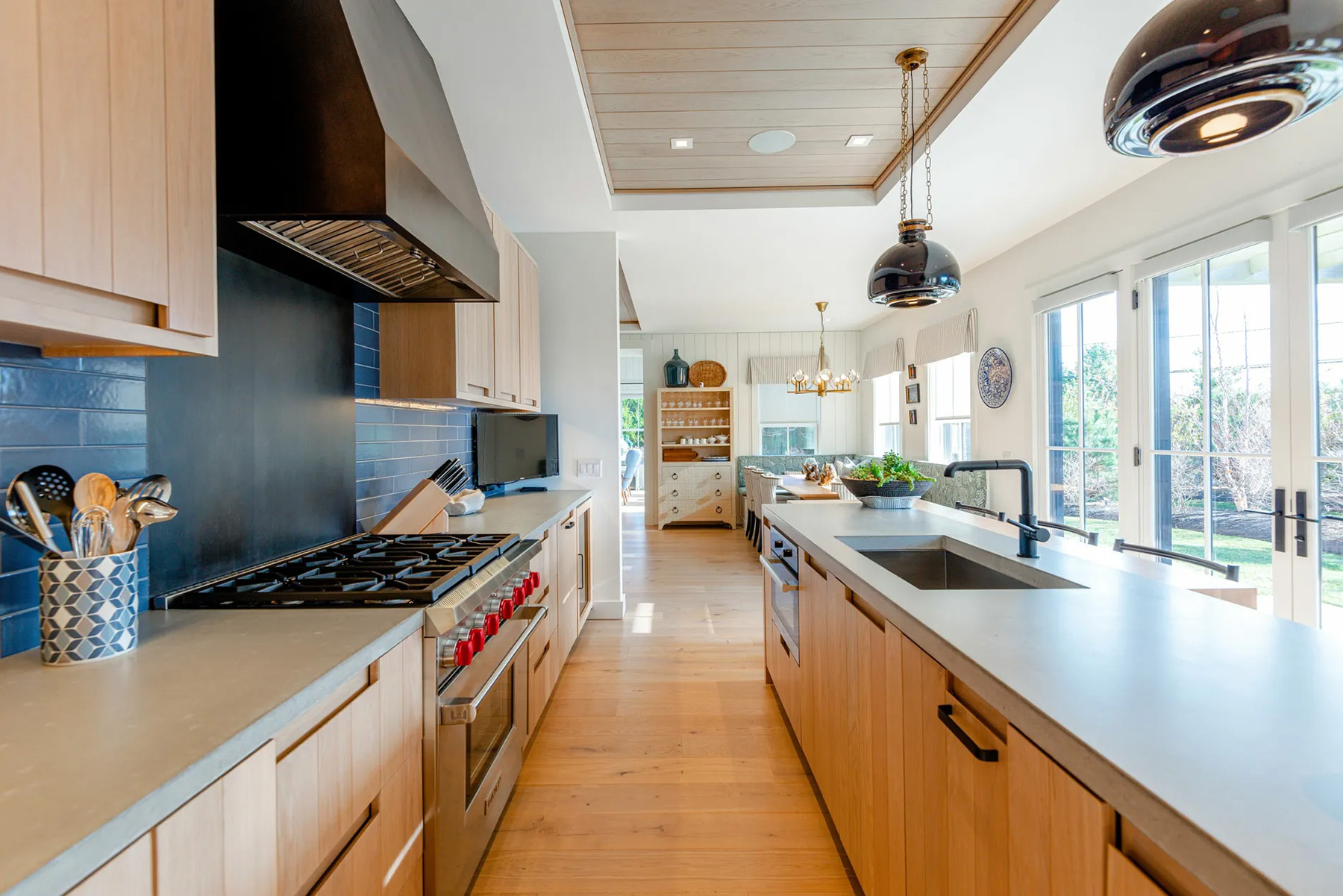
How To Fix Concrete Countertop Cracks
Repairing a hairline or structural crack involves filling the crack with a material that bonds to the concrete. A filer restores the appearance of the countertop and prevent liquids and other materials from falling in. Fillers are usually more flexible and as strong or stronger than the concrete. This help prevent future cracks.
For a List of the Best DIY Concrete Crack Fillers, click the link.
Repairing hairline cracks can be more challenging because they’re so small. But repairing any size crack takes skill, patience and a good eye for color matching. In most cases, it’s impossible to repair and/or seal a crack where the work isn’t visible. Even if you perfectly match the color, the outline of the crack will still be there.
Hairline cracks are very small and haven’t had a chance to open up yet. That means you can only repair it with a very low-viscosity liquid and not cement. Since most hairline cracks don’t affect the structural integrity of a countertop, sealing the crack is the main goal of a repair.
Larger cracks can be filled with a thicker material like fresh cement. If you use the same concrete mix ratio and ingredients as the countertop mix, you’ll be able to match the color perfectly. However, if you didn’t pour the countertops, it usually takes some experimenting to get the color right.
To repair a cracked concrete countertop, you simply fill the crack with the proper material. Bigger cracks are filled with a cement based product. Fine hairline cracks are filled with a very low viscosity liquid.
Unfortunately, even after the cracks are repaired, you can usually still see the outline of the crack, but you can cover the repair up with paint, because concrete countertops can be painted if you know how.
Concrete Countertop Control Joints
Control joints are a separation between two slabs of concrete. By creating a gap between slabs, you allow a space for the slabs to move. This alleviates pressure and helps prevent cracks. Just about all floors, walls, cabinets and homes expand and contract because of temperature fluctuations or moisture. Houses settle after they’ve been built and move in high winds. There are all sorts of reasons why a house can move, and they’re all bad for concrete.
Concrete countertops are very hard, dense and rigid. In fact all concrete is this way. A home’s footings, foundation, sidewalk, driveway, patio or concrete steps can crack if they start to move. Builders take steps to minimize this movement but it can still occur.
In areas we think may move, we install control joints. The joints provide the concrete slabs a place to move so that they don’t crack. These joints are also called expansion joints.
If concrete moves and presses up against another rigid object or slab, that pressure can create a stress crack.
Another way concrete can crack is if the slab twists. If the base cabinets shift and/or twist, and the concrete is connected to the cabinets, it can cause a crack.
Almost all stone countertops have a seam between slabs. It’s very rare that an entire kitchen can have countertops without any seems. Control joints look similar to stone counter seems only they’re more functional. They’re filled with a flexible caulk which allows some slab movement.
If your concrete countertops have some really long sections, it may be beneficial to strategically place a slim control joint in a corner or some other out of the way place.
Are Concrete Countertops High Maintenance?
Concrete countertops do require maintenance, but I wouldn’t consider them high maintenance. They’re about equal to granite, less than marble and a lot more than quartz, or Silestone. Concrete countertops require sealing when first installed to protect the surface of your counter and resist stains. A good quality sealer can last for 1-3 years before it needs to be reapplied. However most contain chemicals. If you use an all natural sealer they only last about 3-4 months.
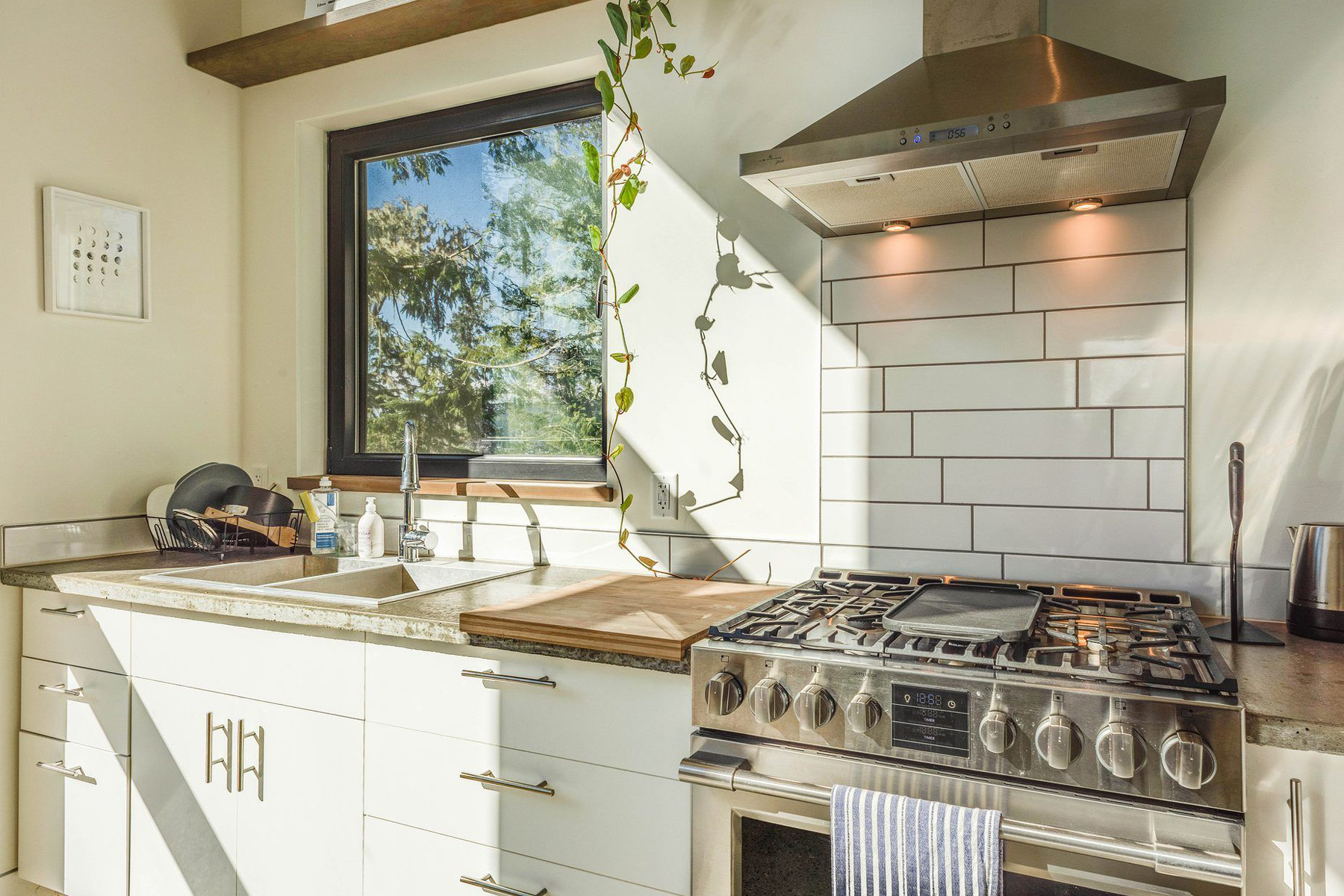
Concrete is a Porous material that stains easily. You should clean spills as soon as possible. Even if the counters are sealed. Avoid spilling ketchup, sauces, oils, grease, acids and juices. Even water can leave spots if it’s not cleaned up quickly.
Granite & Quartzite: The maintenance a concrete counter requires is about the same as granite and quartzite. Both countertop materials are dense enough to resist most scratches but are porous and need a sealer.
Marble: Concrete requires less maintenance than marble. Marble is a very soft stone that scratches easily and it’s porous so it needs a sealer.
Quartz & Silestone: Concrete is a higher maintenance countertops material than quartz and Silestone. Both are very dense, resist scratches and don;t need a sealer.
If you’re looking for the lowest maintenance possible, choose quartz or Silestone. However, concrete is average in terms of maintenance and on par with granite and quartzite and better than marble.
Summary: Do Concrete Countertops Crack?
Concrete countertops can crack just like anything made out of concrete, but not all cracks are the same, and some are more serious than others. There are a few common ways a concrete countertop can crack. The first is structural cracks that run deep into the slab, which are usually caused by an installation error. If the concrete mix ratio is wrong and the concrete is weak, it can crack under its own weight. Concrete countertops can crack if they lack reinforcement like wire mesh or rebar or if it’s not properly supported by the cabinets below. Concrete countertops are strong and can support heavy loads, but only if they’re built properly. A non structural crack is called a hairline. These tiny surface-level cracks are a cosmetic issue and are caused when the concrete dries too quickly.
There’s a big difference between a structural crack and a cosmetic crack. Cosmetic hairline cracks aren’t a big deal on a foundation, driveway, or sidewalk, but they’re a more serious issue when on a countertop. Concrete countertops are a finished product and need a smooth surface free of cracks and large imperfections. A small bubble pit on the side here and there is perfectly fine and can even add to the beauty of the slab, but cracks are a problem.
Concrete countertops crack because of an installation error. This is one of the challenges you’ll face when building your own. Always make sure the concrete mix ratio is correct, that you use the right ingredients, and that the slab is reinforced and supported. Also, make sure that the concrete dries slowly to prevent hairline cracks.
If you have any questions or comments about concrete countertops, email any time.

John Mazzuca | About | More Posts |
Custom Home Builder
John Mazzuca is a custom home designer and builder at Gambrick with over 25 years experience in the construction industry. John has designed, built and/or remodeled hundreds of homes, small buildings, and commercial projects. He writes about business, real estate, home building, and household electronics. His work has been featured in Fox Business, Better Homes & Garden, House Beautiful, and more.















